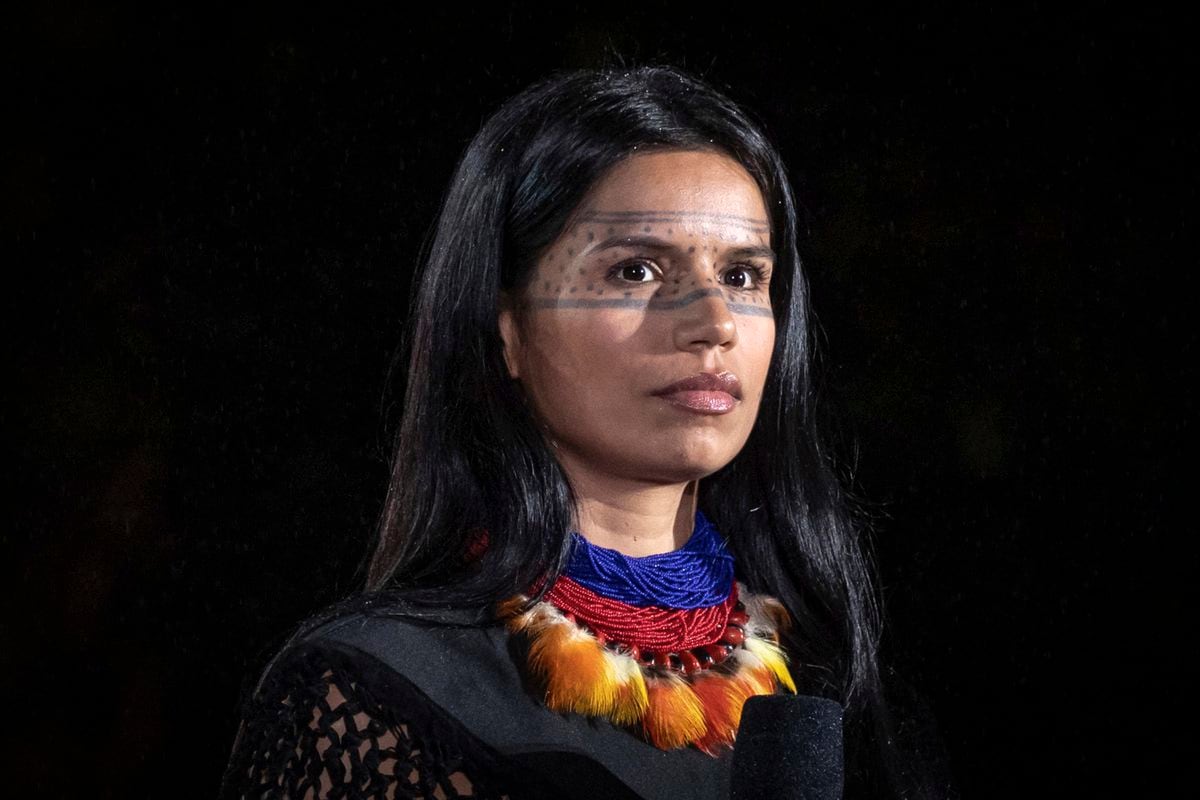Luz Jiménez is the rural teacher that Diego Rivera painted on the walls of the Ministry of Public Education.
She is also the peasant that the muralist portrayed together with the insurgents in the National Palace;
the indigenous woman with braids who sells snacks in
Sueño de un tarde dominicale in the Alameda Central
and the figures that represent faith, wisdom and tradition in the mural
La creación
.
It is the naked Malinche that José Clemente Orozco placed next to Hernán Cortés on the stairs of Colegio de San Ildefonso.
She is the woman with the lyre that Rufino Tamayo drew at the old National Conservatory of Music.
She is the figure holding the pitchers in the sculpture in Parque México.
She is the mother that Jean Charlot portrayed with his daughter in her arms and Frenando Leal's woman crossing herself.
She is a constant presence that has often gone unnoticed.
"Luz Jiménez is part of a legend for many people," says historian Carmen Tostado.
Although she was central to the creation of the national image projected by Mexican muralism at the beginning of the 20th century, her name is little known outside expert circles.
“If you say Frida Kahlo or Nahui Olin, the whole world knows who they are.
If you say Luz Jiménez, I don't think many people know it.
However, it is a presence that is.
How many people go through Parque México and see the Fuente de los Cántaros and don't know who the model is?” says Tostado.
The historian, she is one of the curators of
The Spirit of 22
, an exhibition that is on display until June at the Colegio de San Ildefonso and that, among other things, recovers her story.
“Luz is the face of the Mexican school of painting”, summarizes Tostado.
The Fountain of the pitchers in Parque México, in Colonia Condesa in Mexico City.
The model for this work by the sculptor José María Fernández Urbina was Luz Jiménez. Aggi Garduño
'Cortes and Malinche' by the muralist José Clemente Orozco, in the Antiguo Colegio de San Ildefonso in the Historic Center of Mexico City.Aggi Garduño
'The dancers of Chalma' by the painter Fernando Leal, inside the Antiguo Colegio de San Ildefonso in the Historic Center of Mexico City.Aggi Garduño
The mural 'La creación' by the muralist Diego Rivera in the Simón Bolívar Amphitheater, inside the Colegio de San Ildefonso.
The artist was inspired by Luz Jiménez for three of the female figures. Aggi Garduño
The figures that represent faith, wisdom and tradition, in a detail of the mural 'La creación' inspired by Jiménez (right).
The model used many names and surnames until she chose the final one.
Luz, Luciana, Lucha or Juliana;
Martinez, Perez, Jimenez or Gonzalez.
The real one was Julia Jiménez.
She was born at the end of the 19th century in Milpa Alta, an area surrounded by forested hills in the south of Mexico City.
At the age of 19, when the Revolution reached her town and federal troops massacred her father and other men, she had to flee with her mother and her sisters.
She thus arrived at the town of Santa Anita, where the first School of Outdoor Painting had been founded.
With this initiative, the artists intended to move away from the guidelines of the Academy of San Carlos and the traditions of European painting.
“It is there”, says Tostado, “where the worlds of Luz Jiménez and the painters meet”.
Jesús Villanueva, grandson of the model and guardian of her archive, warns in the book
Luz Jiménez, symbol of an ancient people
that "it is not known exactly how he got involved in the artistic milieu".
One of her theories supposes that the painters of that school convinced her to model after she won a beauty contest;
Another version tells that she found a job advertisement in the center of the city whose only requirement was to "stay still."
Her grandson barely knew her because she was three years old when she passed away, but he has dedicated himself to studying her biography and spreading her legacy.
He wrote that Luz Jiménez was a person "desiring to improve herself."
Maybe that put her in the center.
A week, the artists paid her 22 pesos for modeling, as recorded in receipts kept by the family.
So she also worked for them in jobs that ranged “from maid to cook,” her grandson wrote.
In a 1961 Excelsior article, Luz Jiménez recounted that when Diego Rivera needed her he would go to her town in a truck to look for her: "They had me as if I were from home, with an apartment, telephone, books
.
"
But she was also their friend, especially Jean Charlot, who was the godfather of her daughter, Concha, and from whom she perhaps learned the songs with which she lulled her grandchildren to sleep in French.
On Christmas Eve of 1925, she cooked for him and other friends of hers and this is how the photographer Edward Weston remembered them in his
Diaries
: “Luziana cooked tasty typical Mexican food.
What a bravo the chile!
(...) Conchita was the important guest [sic]”.
Drawing of Luz Jiménez made by Jean Charlot.Jean Charlot Collection
Luz Jiménez also invited the muralist Fernando Leal to make a pilgrimage to the sanctuary of the Lord of Chalma, in the State of Mexico.
He later painted it on the walls of San Ildefonso, between 1922 and 1923. In
La fiesta del Señor de Chalma
, a dancer stares straight ahead, as if possessed, while around characters with masks, girls dressed in white, peasants with candles and other figures participate in the celebration.
Luz Jiménez is there the woman who crosses herself, also the one wearing the blue shawl and the one with her back turned in a skirt.
“Is it a complex relationship, or is it complete?
I don't know," says Tostado.
“Luz knew how to transmit her world, that's why they looked for her.
There were many pretty indigenous girls, but the way she involved them made them bond.
There was a mutual interest and recognition of the world of the other.
I see her, patiently posing for her and looking at them with the same curiosity that they looked at her, ”adds Tostado.
Matylda Figlerowicz, a literary critic and art historian, believes that it “can be described as a turning point” within art circles of the time.
“She wanted to be there and she was good at modelling.
From what everyone tells, she was a very charismatic person and her physique responded to what people wanted to see as an indigenous woman represented in art, ”she points out.
The historian Blanca Garduño has described her "oval face, her vigorous round chin, her straight and braided hair, her dark complexion and robust body."
The critic Alberto Híjar has pointed out a "corporeity that lives up to expectations" and "necessary for the representation of the national".
“But I think we fall short if we just think about it because she was portrayed in so many different ways,” Figlerowicz continues.
Fernando Leal painting Luz in Coyoacán, circa 1920.Francisco Kochen (Col. Fernando Leal Audirac)
The researcher, with a scholarship at Harvard, studies the "extensive intellectual work" that Jiménez did, who collaborated with anthropologists and linguists.
“They would say that she was an 'informant', but she was, rather, a teacher and an author”, writes Figlerowicz in the essay
The formation of the image of Luz Jiménez.
Figlerowicz's work joins that of other academics who in recent years have sought to "change the narrative" about the life and work of the model.
It was she, for example, who taught Charlot Nahuatl.
His are the memories that the historian Fernando Horcasitas narrates in
From Porfirio Díaz to Zapata.
Nahuatl memory of Milpa Alta
.
The only publications that she signed with her name, however, are two texts in the
Mexihkatl Itonalama newspaper.
edited in Nahuatl by anthropologist Robert Barlow, says Figlerowicz.
"This was never a stable source of income for her," warns the art historian, adding: "Everyone wanted to have her around her, but they didn't treat her in the same way."
Luz Jiménez was killed one morning when she was on her way to work.
She was 68 years old.
Although her obituary was published in newspapers, where she noted that she was "well known in art and anthropology circles", she was forgotten after her death.
In 1994, an exhibition that reviewed Charlot's work "rescued" her, her grandson told a conference organized on March 8, 2021. "They realized that there was a model that had an impact on artists," she said. Villanueva.
The grandson said that day that up to 2021 four exhibitions dedicated to his grandmother had been curated, such as one organized by the Casa Estudio Diego Rivera and Frida Kahlo in 2000.
Last January 28, the anniversary of his birth and death, was perhaps the day that his figure had the greatest diffusion among the general public, when Google dedicated a doodle to him, the review that appears on the main page of the search engine
on
dates determined.
Her text describes her as "the most painted woman in Mexico" who, however, was "relatively unknown."
subscribe here
to the
EL PAÍS México
newsletter and receive all the key information on current affairs in this country

/cloudfront-eu-central-1.images.arcpublishing.com/prisa/DIHPMWJV2JFPLFSKBKCFLE7QNI.jpg)

/cloudfront-eu-central-1.images.arcpublishing.com/prisa/PGFLWZYGBFG7FBITHUY7ILSNBQ.jpg)

/cloudfront-eu-central-1.images.arcpublishing.com/prisa/SR636FOCPVBILPCXVP6SLZ5ME4.jpg)
/cloudfront-eu-central-1.images.arcpublishing.com/prisa/ZP4NWHUN7JACK2UZSAHGHFED3E.jpg)
/cloudfront-eu-central-1.images.arcpublishing.com/prisa/L64PMGMKXNDP5EHGZTYIAK3UTU.jpg)







